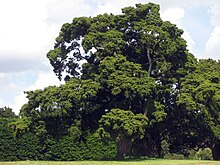Podocarpus totara

| Tōtara | |
|---|---|
 | |
| A tōtara in Auckland, New Zealand | |
| Scientific classification | |
| Kingdom: | Plantae |
| Clade: | Tracheophytes |
| Clade: | Gymnospermae |
| Division: | Pinophyta |
| Class: | Pinopsida |
| Order: | Araucariales |
| Family: | Podocarpaceae |
| Genus: | Podocarpus |
| Species: | P. totara |
| Binomial name | |
| Podocarpus totara | |
Podocarpus totara (/ˈtoʊtərə/),[2] commonly known as the tōtara, is a species of podocarp tree endemic to New Zealand. It grows throughout the North Island, South Island and rarely on Stewart Island / Rakiura in lowland, montane and lower subalpine forest at elevations of up to 600 m.[3]
Tōtara is commonly found in lowland areas where the soil is fertile and well drained.[4] Its Māori name comes from the Proto-Polynesian word *tootara (related to the word tara lit. 'thorn') which when passed down to descendant languages refer to spiny creatures, especially the porcupinefish (Diodon hystrix) due to its spiky leaves.[5] The spelling "totara" without the tohutō is also common in English.
Description
[edit]The tōtara is a medium to large tree, which grows slowly to around 20 to 25 m, exceptionally to 35 m; it is noted for its longevity and the great girth of its trunk. The bark peels off in papery flakes, with a purplish to golden brown hue. The sharp, dull-green, needle-like leaves are stiff and leathery, 2 cm long. This plant produces highly modified cones with two to four fused, fleshy, berry-like, juicy scales, bright red when mature. The cone contains one or two rounded seeds at the apex of the scales.


The largest known living tōtara, the Pouakani Tree, near Pureora in the central North Island, is over 35 m tall and nearly 4 m in trunk diameter at breast height.[6] Bushmen discovered it in 1950.[7] Other large trees are known in this area, while Whirinaki Forest, to the east, but also on deep recent volcanic soils, has groves of very tall tōtara (over 40 m in height).
Tōtara is often found regenerating on farmland, as it is not eaten by livestock.[4]
Varieties
[edit]The two varieties of tōtara are:[8]
- P. t. var. totara
- P. t. var. waihoensis
Related trees
[edit]In a classic example of Antarctic flora species-pair the tōtara is very closely related to Podocarpus nubigenus from South America, to the extent that if planted together, they are very difficult to distinguish. The best distinction is the grey-green tone of the leaves, compared to the slightly brighter green of P. nubigenus.
Cultivation
[edit]
Tōtara grows easily from fresh seed and cuttings.[9] It has been planted in the United Kingdom as far north as Inverewe, Scotland.[10]
Several cultivars for garden use have been introduced. These include 'Albany Gold' and 'Aurea', both have yellow 'gold' foliage that darkens in winter; 'Pendula', which has a weeping growth habit that is especially pronounced in young plants; 'Silver Falls', also pendulous but with cream-edged foliage; and 'Matapouri Blue', which has a conical form and glaucous foliage.
Human use
[edit]The wood is hard, straight-grained, and very resistant to rot, especially its heartwood. Due to its durability, tōtara wood was often used for fence posts, floor pilings, and railway sleepers. It is also prized for its carving properties, and was the primary wood used in Māori carving. It was the primary wood used to make waka in traditional Māori boat building due to its relatively light weight (about 25% lighter than kauri), long, straight lengths, and natural oils in the wood that help prevent rotting. Tōtara could be drilled with chert points to make holes near the edges of the timber without splitting. In larger tōtara waka, three or more sections were laced together with flax rope. A tōtara waka took at least a year to make using stone adzes.
Bark from tōtara is used to cover and protect traditional pōhā bags.[11]
Gallery
[edit]- Receptacle and seed of tōtara
- The reddish-grey bark of the tōtara is thick, corky, furrowed and stringy
References
[edit]- ^ Farjon, A. (2013). "Podocarpus totara". IUCN Red List of Threatened Species. 2013: e.T42537A2985842. doi:10.2305/IUCN.UK.2013-1.RLTS.T42537A2985842.en. Retrieved 12 November 2021.
- ^ "totara". The Chambers Dictionary (9th ed.). Chambers. 2003. ISBN 0-550-10105-5.
- ^ "Podocarpus totara var. totara". New Zealand Plant Conservation Network. Retrieved 2024-02-11.
- ^ a b "Story: Conifers – Tōtara group". Te Ara - the Encyclopedia of New Zealand. Retrieved 30 September 2012.
- ^ Benton, R. A. (2010). "Tōtara". Te Māra Reo. Benton Family Trust. Retrieved 2024-02-11.
- ^ Simpson, Philip (19 June 2017). Totara: A Natural and Cultural History. Auckland University Press. ISBN 978-1-77558-915-0.
- ^ "News of the Day GISBORNE HERALD". paperspast.natlib.govt.nz. 31 Oct 1950. Retrieved 2020-03-29.
- ^ Eagle, Audrey (2008). Eagle's complete trees and shrubs of New Zealand volume one. Wellington: Te Papa Press. p. 8. ISBN 9780909010089.
- ^ "Podocarpus totara var. totara". New Zealand Plant Conservation Network. Retrieved 23 September 2012.
- ^ "Half-hardy trees in Britain and Ireland – part two" (PDF). Royal Horticultural Society. Archived from the original (PDF) on March 3, 2009. Retrieved 2009-06-18.
- ^ "Landcare Research Manaaki Whenua: Māori Plant Use". Manaaki Whenua – Landcare Research. Retrieved 21 November 2019.
External links
[edit]- Farjon, A. (2013). "Podocarpus totara". IUCN Red List of Threatened Species. 2013: e.T42537A2985842. doi:10.2305/IUCN.UK.2013-1.RLTS.T42537A2985842.en. Retrieved 12 November 2021..
- New Zealand Plant Conservation Network, URL: Podocarpus totara var. totara. Accessed 2010-10-03.
- New Zealand Plant Conservation Network, URL: Podocarpus totara var. waihoensis. Accessed 2010-10-03.


